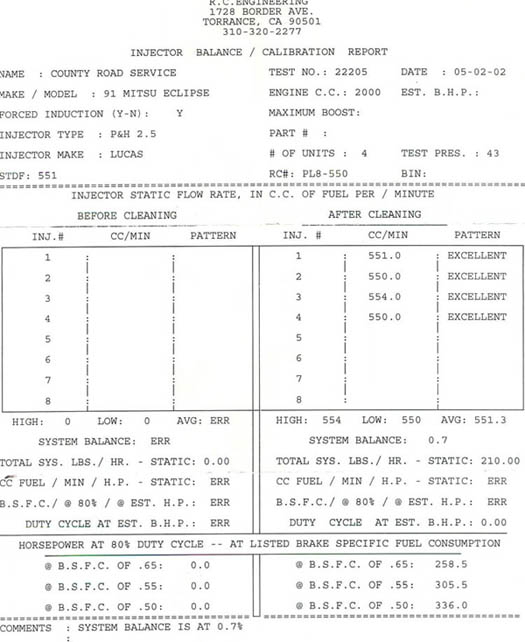 Injector Physical Size Comparison
The stock injectors(picture on top) are 240cc injectors that came in the B16A and problably identical to the ones in your Honda right now. The bottom set are the RC sprayers. RC makes injectors from any cc or lb/min for any fuel injected application. They also offer stock upgrades and cleaning to improve and increase flow of the stock units. You can check out there site at RC Engineering for any questions or comments, they are very cool people to deal with.
Injector Physical Size Comparison
The stock injectors(picture on top) are 240cc injectors that came in the B16A and problably identical to the ones in your Honda right now. The bottom set are the RC sprayers. RC makes injectors from any cc or lb/min for any fuel injected application. They also offer stock upgrades and cleaning to improve and increase flow of the stock units. You can check out there site at RC Engineering for any questions or comments, they are very cool people to deal with. |
|
Injector Balance/Calibration Chart
The test process is as follows: first, your injectors are installed on RC Engineering's custom- designed-and-built, computer-controlled injector flow-testing equipment. A unique, non-flammable, gasoline-like test fluid is pumped at a precisely-controlled pressure through the injectors while they are pulsed by injector-drivers built into the equipment. The volume of fuel passed through the injector is accurately measured for a set amount of time and from those figures, fuel flow is derived. During the flow- test, the injector spray patterns are visually inspected and analyzed by RC's technicians using both bright room and strobe lights.
After the initial flow-test, your injectors are transferred to an ultrasonic cleaning machine and connected to injector drivers. They are submerged in cleaning solution and pulsed while being subjected to ultrasonic waves. The combination of the solution and the ultrasound aggressively clean the internal and external parts of the injectors.
Finally, the now-clean injectors are reinstalled on the flow-tester and run again. At the conclusion of the test, a printed report is produced. This report lists: fuel flow rates (in pounds-per-hour and cubic centimeters per minute) before and after cleaning, and spray pattern assessments for each injector tested. Also included is the "system balance" number which is the flow difference, expressed in a percentage, between the injectors having the highest and lowest flow rates amongst the lot of injectors tested. The system's total fuel delivery in lbs/hr. and cc/min along with a computation of potential horsepower at three different brake specific fuel consumption rates concludes the report.
Brake specific should be
.45 to .50 for N/A engines,
.55 TO .60 for supercharged engines,
and .60 to .65 for turbocharged engines
At this rate at 80% our supportable HP #'s are as follows according to the above chart:
0.50 - 336 N/A HP
0.55 - 305 S/C HP
0.65 - 258 T/C HP
|
|
What RC tests for
The purpose of cleaning and flow-testing is to 1) remove any contaminants inside or outside the injector that impede fuel flow or degrade fuel spray pattern 2) to accurately measure each injector's fuel flow ability and 3) acquire quantitative data on injector performance the vehicle owner can use in matching injectors or tuning the engine's fuel system.
Props to Turbotrix.com
While searching the net, I stumbled across TURBOTRIX and found the site to be very informative. They usually deal with the Diamond Star variety, but we won't hold that against them. All joking aside they were really professional and easy to deal with and ready to answer any question. They sell all types of upgrades from turbos to well, injectors. We picked up this set for 84 dollars a pop plus S&H. If you have any questions Jeff is a cool guy and is ready to answer your boost related inquiries. You can catch em @:
Turbotrix 269 County Road Tenafly, NJ 07670
Phone: (201) 568-3008 Fax: (201) 568-7247
Business hours: M-F 7am-5pm EST, Sat Closed
Email: jeff@turbotrix.com
|
 Our Injector Balance / Calibration Results
Our Injector Balance / Calibration Results
|